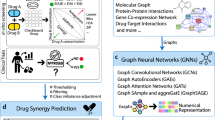Abstract
Mutated epidermal growth factor receptor (EGFR-T790M) inhibitors hold promise as new agents against cancer. Molecular docking and QSAR analysis were performed based on a series of fifty-three quinazoline derivatives to elucidate key structural and physicochemical properties affecting inhibitory activity. Molecular docking analysis identified the true conformations of ligands in the receptor’s active pocket. The structural features of the ligands, expressed as molecular descriptors, were derived from the obtained docked conformations. Non-linear and spline QSAR models were developed through novel genetic algorithm and artificial neural network (GA-ANN) and multivariate adaptive regression spline techniques, respectively. The former technique was employed to consider non-linear relation between molecular descriptors and inhibitory activity of quinazoline derivatives. The later technique was also used to describe the non-linearity using basis functions and sub-region equations for each descriptor. Our QSAR model gave a high predictive performance \((R_{\mathrm{p}}^{2}=0.881, Q_{\mathrm{LOO}}^{2}=0.923, R^{2}_{\mathrm{LSO}}=0.828\) and \(r_{\mathrm{m}}^{2}=0.772\)) using diverse validation techniques. Eight new compounds were designed using our QSAR model as potent EGFR-T790M inhibitors. Overall, the proposed in silico strategy based on docked derived descriptor and non-linear descriptor subset selection may help design novel quinazoline derivatives with improved EGFR-T790M inhibitory activity.





Similar content being viewed by others
References
Wang C, Gao H, Dong J, Wang F, Li P, Zhang J (2014) Insight into the medicinal chemistry of EGFR and HER-2 inhibitors. Curr Med Chem 21:1336–1350. doi:10.2174/0929867320666131119124646
Chaft JE, Oxnard GR, Sima CS, Kris MG, Miller VA, Riely GJ (2011) Disease flare after tyrosine kinase inhibitor discontinuation in patients with EGFR-mutant lung cancer and acquired resistance to erlotinib or gefitinib: implications for clinical trial design. Clin Cancer Res 17:6298–6303. doi:10.1158/1078-0432.CCR-11-1468
Suda K, Onozato R, Yatabe Y, Mitsudomi T (2009) EGFR T790M mutation: a double role in lung cancer cell survival? J Thorac Oncol 4:1–4. doi:10.1097/JTO.0b013e3181913c9f
Lacouture ME (2006) Mechanisms of cutaneous toxicities to EGFR inhibitors. Nat Rev Cancer 6:803–812. doi:10.1038/nrc1970
Choong NW, Dietrich S, Seiwert TY, Tretiakova MS, Nallasura V, Davies GC, Lipkowitz S, Husain AN, Salgia R, Ma PC (2006) Gefitinib response of erlotinib-refractory lung cancer involving meninges role of EGFR mutation. Nat Clin Pract Oncol 3:50–57. doi:10.1038/ncponc0400
Zhang L, Yang Y, Zhou H, Zheng Q, Li Y, Zheng S, Zhao S, Chen D, Fan C (2015) Structure-activity study of quinazoline derivatives leading to the discovery of potent EGFR-T790M inhibitors. Eur J Med Chem 102:445–463. doi:10.1016/j.ejmech.2015.08.026
Muratov EN, Varlamova EV, Artemenko AG, Polishchuk PG, Kuz’min VE (2012) Existing and developing approaches for QSAR analysis of mixtures. Mol Inform 31:202–221. doi:10.1002/minf.201100129
Kovalishyn V, Poda G (2015) Efficient variable selection batch pruning algorithm for artificial neural networks. Chemom Intell Lab Syst 149:10–16. doi:10.1016/j.chemolab.2015.10.005
Kooperberg C (2006) Multivariate adaptive regression splines, in encyclopedia of environmetrics. Wiley, Chichester
Heinzerling L, Klein R, Rarey M (2012) Fast force field-based optimization of protein-ligand complexes with graphics processor. J Comput Chem 33:2554–2565. doi:10.1002/jcc.23094
VCCLAB, Virtual Computational Chemistry Laboratory, Milan. http://www.vcclab.org/lab/edragon/
Todeschini R, Consonni V, Mannhold R, Kubinyi H, Folkers G (2009) Molecular descriptors for chemoinformatics, vol 41. Wiley, New York
Asadollahi-Baboli M, Mani-Varnosfaderani A (2015) Therapeutic index modeling and predictive QSAR of novel thiazolidin-4-one analogs against \(Toxoplasma\,gondii\). Eur J Pharm Sci 70:117–124. doi:10.1016/j.ejps.2015.01.014
Jalali-Heravi M, Asadollahi-Baboli M (2008) QSAR analysis of platelet-derived growth inhibitors using GA-ANN and shuffling crossvalidation. QSAR Comb Sci 27:750–757. doi:10.1002/qsar.200710138
Yamashita N, Fukushima M (2001) On the rate of convergence of the Levenberg-Marquardt Method. In: Alefeld G, Chen X (eds) Topics in numerical analysis. Springer, Vienna, pp 239–249
Friedman JH (1991) Multivariate adaptive regression splines. Ann Stat 19:1–67
MATLAB 11.1. The Mathworks, Inc., Natick. http://www.mathworks.com/
Von Lilienfeld OA, Ramakrishnan R, Rupp M, Knoll A (2015) Fourier series of atomic radial distribution functions: a molecular fingerprint for machine learning models of quantum chemical properties. Int J Quantum Chem 115:1084–1093. doi:10.1002/qua.24912
Todeschini R, Gramatica P (1998) New 3D molecular descriptors: the WHIM theory and QSAR applications. In: Kubinyi H, Folkers G, Martin YC (eds) 3D QSAR in drug design. Springer, Dordrecht
Devinyak O, Havrylyuk D, Lesyk R (2014) 3D-MoRSE descriptors explained. J Mol Graph Modell 54:194–203. doi:10.1016/j.jmgm.2014.10.006
Saíz-Urra L, Pérez González M, Teijeira M (2007) 2D-autocorrelation descriptors for predicting cytotoxicity of naphthoquinone ester derivatives against oral human epidermoid carcinoma. Biorg Med Chem 15:3565–3571. doi:10.1016/j.bmc.2007.02.032
Gramatica P (2014) External Evaluation of QSAR Models, in Addition to Cross-Validation: Verification of Predictive Capability on Totally New Chemicals. Mol Inform 33:311–314. doi:10.1002/minf.201400030
Asadollahi-Baboli M (2012) Quantitative structure-activity relationship analysis of human neutrophil elastase inhibitors using shuffling classification and regression trees and adaptive neuro-fuzzy inference systems. SAR & QSAR Environ Res 23:505–520. doi:10.1080/1062936X.2012.696552
Sagrado S, Cronin MTD (2008) Application of the modelling power approach to variable subset selection for GA-PLS QSAR models. Anal Chim Acta 609:169–174. doi:10.1016/j.aca.2008.01.013
Roy K, Kar S, Ambure P (2015) On a simple approach for determining applicability domain of QSAR models. Chemom Intell Lab Syst 145:22–29. doi:10.1016/j.chemolab.2015.04.013
Author information
Authors and Affiliations
Corresponding author
Ethics declarations
Conflict of interest
The author declares that there are no conflicts of interest.
Rights and permissions
About this article
Cite this article
Asadollahi-Baboli, M. In silico evaluation, molecular docking and QSAR analysis of quinazoline-based EGFR-T790M inhibitors. Mol Divers 20, 729–739 (2016). https://doi.org/10.1007/s11030-016-9672-0
Received:
Accepted:
Published:
Issue Date:
DOI: https://doi.org/10.1007/s11030-016-9672-0




